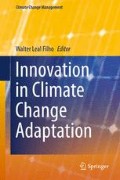Abstract
The paper examined the influence of climate change on cocoyam production in Aba agricultural zone of Abia State. Data for the study was collected using a participatory pair-wise ranking technique from Key cocoyam farmers, village chiefs and Agricultural extension agents in a Focused group discussion and in-depth interview. Findings revealed that the major occupation of the people in the area is farming while the major crops grown are yam, cassava and plantain. Cassava ranked first as the major source of both income and food. On the average, size of farm is 0.3 ha while land acquisition is majorly by inheritance and leasing. The major source of labour is family members and hired labored. The cocoyam cultivars grown in the area are Edeocha, Ede Uhie, okpanambe, and Ede ofe. Farmer’s previous harvest and neighbor are the major source of planting material. Major cropping pattern done in the area is mixed cropping while crops planted with cocoyam include Maize, groundnut and vegetables. Farmers aim of producing cocoyam is for consumption and sometimes sales. All farmers agreed that there is a change in the climate of their zone. The major climate variables that is changing and as well affecting cocoyam production in the zone according to the farmers are rainfall, heat (atmospheric temperature) and sunshine (solar radiation) while the major influence of climate change on cocoyam production include decline in yield of cocoyam, reduction of soil fertility, uncertainty in planting and harvesting date, stunted growth of cocoyam, increase in decay of planted corms/cormels and increase loss during storage in the barns. The study then recommends that access to and cost of fertilizer should be enhanced and subsidized by the Government, this will help farmers to have access to fertilizer thereby overcoming the problem of soil fertility reduction. It further recommends that improved storage facility should be put in place to reduce the huge loss encountered during storage.
Access this chapter
Tax calculation will be finalised at checkout
Purchases are for personal use only
References
Amusa TA, Enete AA, Okon UE (2011) Socio-economic determinants of cocoyam production among small holder farmers in Ekiti state, Nigeria. Int J Agric Econ Rural Dev 4(2):97–109
Chukwu GO, Nwosu KI, Mbanaso ENA, Enyinnaya AM (2010) Field production of cocoyams. In: Ukpabi UJ, Nwosu KI (eds) Yam, cocoyam and sweet potato. Production and post-harvest management. National Root Crops Research Institute (NRCRI), Umudike
Echebiri RN (2004) Socio-economic factors and resource allocation in cocoyam production in Abia State, Nigeria: a case study. J Sustain Trop Agric Res 9:69–73
Ezemonye MN, Emeribe CN (2012) Rainfall erosivity in Southeastern Nigeria. Ethiop J Environ Stud Manag (EJESM) 5(2):112–122
FAOSTAT (2005) Statistical database. Agricultural production of primary crops. Food and Agriculture Organisations of the United Nations (FAOSTAT), Washington, DC
FAO Statistics (2007) Food and Agriculture Organisation database results. FAO, Rome
Ifeanyi-obi CC, Adesope OM, Issa FO, Ugwuja VC (2013) Organic agriculture as a resuscitating option for cocoyam production in Nigeria. Int J Appl Res Technol 2(6)
Ingram J (2011) A food systems approach to researching food security and its interactions with global environmental change. Food Secur 3:417–431
Mbakwe R, Ukachukwu SN, Muoneke CO, Ekeleme F (2004) Problem identification and development of research base. In: Umunna RPA, Onwudike OC, Uwaegbute AC, Edeoga HO, Nwosu AC (eds) Farming systems research and development in Nigeria—principles and practice in Humid and derived Savanna southeast zone. Michael Okpara University of Agriculture, Umudike
Mbanaso ENA (2007) Cocoyam program. www.nrcri.gov.ng/page/cocoyam.html
Mwenye OJ, Labuschangne MT, Herselman L, Benesi IRM (2011) Mineral composition of Malawian cocoyam (Colocassia esculenta and Xanthosoma sagittifolium genotypes). J Biol Sci 11(4):331–335
NIMET (2010) Nigeria climate review bulletin 2010. Nigeria Meteorological Agency (NIMET). http://www.nimetng.org/uploads/publication/2010%20Climate%20Review.pdf. Retrieved 11 Mar 2015
Okoye BC, Onyenweaku CE, Ukoha OO, Asumugha GN, Aniedu OC (2008) Determinants of labour productivity on small-holder cocoyam farms in Anambra State, Nigeria. J Sci Res Essay 3:559–561
Onwubuya EA, Ajani EN (2012) Strategies to improve the production and processing of cocoyam among women farmers in Anambra state, Nigeria. Univers J Educ Gen Stud 1(6):169–173
Onyeka TJ, Nwokocha HN (2010) Important diseases and pests of cocoyam and their management. In: Ukpabi UJ, Nwosu KI (eds) Yam, cocoyam and sweet potato. Production and post-harvest management. National Root Crops Research Institute (NRCRI), Umudike
Ozor N (2009) Understanding climate change: implication for Nigerian agriculture. Policy and education. In: Paper presented at the national conference on climate change and the Nigerian environment, organized by the department of geography. University of Nigeria, Nsukka, 29 July–2 Aug 2009
Parkinson S (1984) The contribution of aroids in the nutrition of people in the south pacific. In: Chandra S (ed) Edible aroids. Clarendon, Oxford, UK, pp 215–224
Schmidhuber J, Tubiello FN (2007) Global food security under climate change. Proc Natl Acad Sci USA 104:19703–19708
Ugbajah M (2013) Enhancing income through cocoyam production, processing, and consumption patterns, in Dunukofia local government area of Ambra state, Nigeria. Green J Soc Sci 3(6):334–339
Ukonze JA (2012) Impact of climate change on cocoyam production in South Eastern Nigeria. Int J Educ Sci Public Policy Afr 2(1):161–168
Vermeulen SJ, Campbell BM, Ingram JSI (2012) Climate change and food systems. Annu Rev Environ Resour 37:195–222
Ziervogel G, Ericksen PJ (2010) Adapting to climate change to sustain food security. WIREs Clim Change 1:525–540
Acknowledgements
This research is supported by funding from the Department for International Development (DfID) under the Climate Impact Research Capacity and Leadership Enhancement (CIRCLE) programme.
Author information
Authors and Affiliations
Corresponding author
Editor information
Editors and Affiliations
Rights and permissions
Copyright information
© 2016 Springer International Publishing Switzerland
About this chapter
Cite this chapter
Ifeanyi-obi, C.C., Togun, A.O., Lamboll, R. (2016). Influence of Climate Change on Cocoyam Production in Aba Agricultural Zone of Abia State, Nigeria. In: Leal Filho, W. (eds) Innovation in Climate Change Adaptation. Climate Change Management. Springer, Cham. https://doi.org/10.1007/978-3-319-25814-0_18
Download citation
DOI: https://doi.org/10.1007/978-3-319-25814-0_18
Published:
Publisher Name: Springer, Cham
Print ISBN: 978-3-319-25812-6
Online ISBN: 978-3-319-25814-0
eBook Packages: Economics and FinanceEconomics and Finance (R0)

